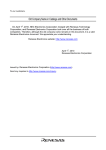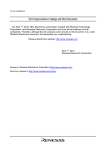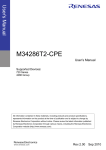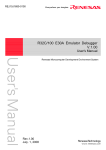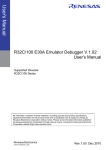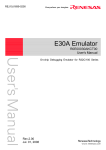Download E30A Emulator for the R32C/100 Series Application Note How to
Transcript
To our customers,
Old Company Name in Catalogs and Other Documents
On April 1st, 2010, NEC Electronics Corporation merged with Renesas Technology
Corporation, and Renesas Electronics Corporation took over all the business of both
companies. Therefore, although the old company name remains in this document, it is a valid
Renesas Electronics document. We appreciate your understanding.
Renesas Electronics website: http://www.renesas.com
April 1st, 2010
Renesas Electronics Corporation
Issued by: Renesas Electronics Corporation (http://www.renesas.com)
Send any inquiries to http://www.renesas.com/inquiry.
Notice
1.
2.
3.
4.
5.
6.
7.
All information included in this document is current as of the date this document is issued. Such information, however, is
subject to change without any prior notice. Before purchasing or using any Renesas Electronics products listed herein, please
confirm the latest product information with a Renesas Electronics sales office. Also, please pay regular and careful attention to
additional and different information to be disclosed by Renesas Electronics such as that disclosed through our website.
Renesas Electronics does not assume any liability for infringement of patents, copyrights, or other intellectual property rights
of third parties by or arising from the use of Renesas Electronics products or technical information described in this document.
No license, express, implied or otherwise, is granted hereby under any patents, copyrights or other intellectual property rights
of Renesas Electronics or others.
You should not alter, modify, copy, or otherwise misappropriate any Renesas Electronics product, whether in whole or in part.
Descriptions of circuits, software and other related information in this document are provided only to illustrate the operation of
semiconductor products and application examples. You are fully responsible for the incorporation of these circuits, software,
and information in the design of your equipment. Renesas Electronics assumes no responsibility for any losses incurred by
you or third parties arising from the use of these circuits, software, or information.
When exporting the products or technology described in this document, you should comply with the applicable export control
laws and regulations and follow the procedures required by such laws and regulations. You should not use Renesas
Electronics products or the technology described in this document for any purpose relating to military applications or use by
the military, including but not limited to the development of weapons of mass destruction. Renesas Electronics products and
technology may not be used for or incorporated into any products or systems whose manufacture, use, or sale is prohibited
under any applicable domestic or foreign laws or regulations.
Renesas Electronics has used reasonable care in preparing the information included in this document, but Renesas Electronics
does not warrant that such information is error free. Renesas Electronics assumes no liability whatsoever for any damages
incurred by you resulting from errors in or omissions from the information included herein.
Renesas Electronics products are classified according to the following three quality grades: “Standard”, “High Quality”, and
“Specific”. The recommended applications for each Renesas Electronics product depends on the product’s quality grade, as
indicated below. You must check the quality grade of each Renesas Electronics product before using it in a particular
application. You may not use any Renesas Electronics product for any application categorized as “Specific” without the prior
written consent of Renesas Electronics. Further, you may not use any Renesas Electronics product for any application for
which it is not intended without the prior written consent of Renesas Electronics. Renesas Electronics shall not be in any way
liable for any damages or losses incurred by you or third parties arising from the use of any Renesas Electronics product for an
application categorized as “Specific” or for which the product is not intended where you have failed to obtain the prior written
consent of Renesas Electronics. The quality grade of each Renesas Electronics product is “Standard” unless otherwise
expressly specified in a Renesas Electronics data sheets or data books, etc.
“Standard”:
8.
9.
10.
11.
12.
Computers; office equipment; communications equipment; test and measurement equipment; audio and visual
equipment; home electronic appliances; machine tools; personal electronic equipment; and industrial robots.
“High Quality”: Transportation equipment (automobiles, trains, ships, etc.); traffic control systems; anti-disaster systems; anticrime systems; safety equipment; and medical equipment not specifically designed for life support.
“Specific”:
Aircraft; aerospace equipment; submersible repeaters; nuclear reactor control systems; medical equipment or
systems for life support (e.g. artificial life support devices or systems), surgical implantations, or healthcare
intervention (e.g. excision, etc.), and any other applications or purposes that pose a direct threat to human life.
You should use the Renesas Electronics products described in this document within the range specified by Renesas Electronics,
especially with respect to the maximum rating, operating supply voltage range, movement power voltage range, heat radiation
characteristics, installation and other product characteristics. Renesas Electronics shall have no liability for malfunctions or
damages arising out of the use of Renesas Electronics products beyond such specified ranges.
Although Renesas Electronics endeavors to improve the quality and reliability of its products, semiconductor products have
specific characteristics such as the occurrence of failure at a certain rate and malfunctions under certain use conditions. Further,
Renesas Electronics products are not subject to radiation resistance design. Please be sure to implement safety measures to
guard them against the possibility of physical injury, and injury or damage caused by fire in the event of the failure of a
Renesas Electronics product, such as safety design for hardware and software including but not limited to redundancy, fire
control and malfunction prevention, appropriate treatment for aging degradation or any other appropriate measures. Because
the evaluation of microcomputer software alone is very difficult, please evaluate the safety of the final products or system
manufactured by you.
Please contact a Renesas Electronics sales office for details as to environmental matters such as the environmental
compatibility of each Renesas Electronics product. Please use Renesas Electronics products in compliance with all applicable
laws and regulations that regulate the inclusion or use of controlled substances, including without limitation, the EU RoHS
Directive. Renesas Electronics assumes no liability for damages or losses occurring as a result of your noncompliance with
applicable laws and regulations.
This document may not be reproduced or duplicated, in any form, in whole or in part, without prior written consent of Renesas
Electronics.
Please contact a Renesas Electronics sales office if you have any questions regarding the information contained in this
document or Renesas Electronics products, or if you have any other inquiries.
(Note 1) “Renesas Electronics” as used in this document means Renesas Electronics Corporation and also includes its majorityowned subsidiaries.
(Note 2) “Renesas Electronics product(s)” means any product developed or manufactured by or for Renesas Electronics.
Application Note
E30A Emulator for the R32C/100 Series
How to Use Trace and Section Time Measurement Events
Summary
The E30A emulator for the R32C/100 series incorporates two debug functions—the trace function and the
section time measurement function. By selecting trace or time measurement for the event and then
specifying access conditions in the event setup screen of High-performance Embedded Workshop (HEW), it
is possible to perform a trace or section time measurement.
The results of trace and section time measurement can each be confirmed in the trace window and the
time section measurement window of HEW.
The access conditions selectable for each event are listed below.
Access condition
Event
EXECUTION
BRANCH
READ
WRITE
R/W
Trace event (trace extraction event)
¯
{
{
{
{
Trace event (trace start event/ trace end
event) *1
{
¯
{
{
{
Section time measurement event
¯
¯
{
{
{
*1. Can be assigned to only events E0 and E4.
Limitations on access conditions of each event are shown below.
[Limitations of trace events]
If EXECUTION is specified for access condition of a trace, the emulator, owing to NSD specifications, may
erroneously assume that the condition is met when the set address is prefetched *2 (prefetched in size of
about 48 bytes). This will result in excessive trace information being acquired or a failure to acquire the
intended trace information depending on trace measurement range (After or Before).
*2. Although it is possible to set an address for the trace event condition by taking prefetch into
consideration, such is not a much practiced case because there are various factors such as interrupt
process, branch process, loop process, or compiler optimization that make it difficult to identify the address.
[Limitations of section time measurement events]
Since the section time measurement is an operation to measure the execution time between data
accesses based on trace information, the data access trace information (address, data, data size,
read/write) is detected in the emulator as the measurement start event and measurement end event.
Therefore, it is only data access (READ, WRITE, or R/W) that can be specified for access condition, and in
no case can such a time measurement that uses the start and end of a function as condition be performed
(i.e., EXECUTION cannot be specified for access condition).
This application note explains the measures to be taken to cope with the above limitations.
REJ06J0073-0100/Rev.1.00
2009.3
Page 1 of 19
E30A Emulator for the R32C/100 Series
How to Use Trace and Section Time Measurement Events
Table of Contents
1.
Environment ...................................................................................................................................... 3
2. Flow of This Document ..................................................................................................................... 3
2.1 Trace Based on Data Access............................................................................................................ 4
2.2 Section Time Measurement Based on Data Access......................................................................... 8
3.
Frequency Asked Questions ........................................................................................................... 13
4.
Related Documents......................................................................................................................... 17
REJ06J0073-0100/Rev.1.00
2009.3
Page 2 of 19
E30A Emulator for the R32C/100 Series
How to Use Trace and Section Time Measurement Events
1.
Environment
Microcomputers used: R32C/118 group (R5F64189PFB)
HEW: V.4.05.01.001
Emulator software: R32C/100 E30A Emulator Debugger V.1.00 Release 00
Compiler: R32C/100 Series C Compiler V.1.01 Release 00
2.
Flow of This Document
The corrective measures are described below.
[Corrective measures for limitations on trace events]
• Embed a sequence in place that will have a data access (read process *3) generated at the start position
of a trace and specify the data access for access condition (alteration of the source required).
*3. If a write process is used for condition, because a trace event cannot have data comparison set for
condition (e.g., a condition like the one that will cause a trace to start when variable ‘a’ = 1), a trace may
erroneously be started at the time the data (variable) set for access condition is initialized (by writing “00”),
making it impossible to trace the intended range.
(For details, see paragraph (4) in Section 3, “Frequently Asked Questions.”)
[Corrective measures for limitations on section time measurement events]
• Embed a sequence in place that will have a data access generated in a section of the program (start to
end) in which a time measurement is to be performed and specify the data access for access condition
(alteration of the source required).
The flow of this document is shown below.
Operation start
Trace based on data access
Section time measurement based on data
access
End
REJ06J0073-0100/Rev.1.00
2009.3
Page 3 of 19
E30A Emulator for the R32C/100 Series
How to Use Trace and Section Time Measurement Events
2.1 Trace Based on Data Access
This section explains the method for performing a trace unaffected by prefetch by first embedding a global
variable read process at the start position of a trace event and then specifying the global variable read
process (data access) for the event’s access condition.
Shown here is an example in which a trace is started from the beginning of the sort function by using the
Tutorial program included with the E30A emulator software.
(1) Add global variables point and trace_point in the source file.
(2) Add point = trace_point at a place preceding the sort function. Perform a build after adding and then
download the program.
Trace starts from here.
(3) Choose Trace from the View menu and then select Trace Point.
REJ06J0073-0100/Rev.1.00
2009.3
Page 4 of 19
E30A Emulator for the R32C/100 Series
How to Use Trace and Section Time Measurement Events
(4) The Event Settings dialog box is displayed. Double-click in the Event Status column.
Double-click here.
(5) The Set Event Status dialog box is displayed. Select Trace for Event Type, AFTER for Trace
Measurement Range, trace_point for Start Address, and READ for Access Condition. Then click the
OK button.
REJ06J0073-0100/Rev.1.00
2009.3
Page 5 of 19
E30A Emulator for the R32C/100 Series
How to Use Trace and Section Time Measurement Events
(6) The contents you’ve set are displayed in the Event Settings dialog box. Click the Set button to make
the changes take effect.
(7) Choose Trace from the View menu and then select Trace.
REJ06J0073-0100/Rev.1.00
2009.3
Page 6 of 19
E30A Emulator for the R32C/100 Series
How to Use Trace and Section Time Measurement Events
(8) The Trace window is displayed.
(9) Run the program and stop, and the result of a trace will be displayed. Although one event has just
been used in the global variable process (data access) specified for access condition, a trace can be
started from the beginning of the sort function.
REJ06J0073-0100/Rev.1.00
2009.3
Page 7 of 19
E30A Emulator for the R32C/100 Series
How to Use Trace and Section Time Measurement Events
2.2 Section Time Measurement Based on Data Access
This section explains the method for measuring the execution time (from start to end) of a function by
embedding a global variable write process at the start and end positions of a section time measurement
event and then specifying the global variable write process (data access) for the event’s access condition.
Shown here is an example in which measurement is made of the execution time of the sort function by
using the Tutorial program included with the E30A emulator software.
(1) Add global variables time_start and time_stop in the source file.
(2) Add time_start = 1 and time_stop = 1 before and after the sort function. Perform a build after adding
and then download the program.
Measurement is
taken of this
section.
(3) Choose Trace from the View menu and then select Section Time Measurement.
REJ06J0073-0100/Rev.1.00
2009.3
Page 8 of 19
E30A Emulator for the R32C/100 Series
How to Use Trace and Section Time Measurement Events
(4) The Section Time Measurement dialog box is displayed. Double-click in the Event Status column.
Double-click here.
(5) The Set Event Status dialog box is displayed. Select Time Measurement for Event Type, check the
Section Time Measurement and the Data Comparison check boxes and uncheck the Execution Time
Measurement check box. Select _time_start for Address and WRITE for Access Condition and set
Data to “00000001." Then click the OK button.
REJ06J0073-0100/Rev.1.00
2009.3
Page 9 of 19
E30A Emulator for the R32C/100 Series
How to Use Trace and Section Time Measurement Events
In the same way, complete the dialog box by selecting _time_stop for Address etc. as shown below,
and then click the OK button.
(6) The contents you’ve set are displayed in the Section Time Measurement dialog box. At this time,
check to see if _time_start and _time_stop are set for events E1 and E2, respectively. Next, select
MP1 in the Measurement Points column and double-click in it.
Double-click here.
REJ06J0073-0100/Rev.1.00
2009.3
Page 10 of 19
E30A Emulator for the R32C/100 Series
How to Use Trace and Section Time Measurement Events
(7) The Set Measurement Point: MP1 dialog box is displayed. Select E1 for Start and E2 for End, and
then click the OK button. This setting causes a measurement to be made from when event E1 occurs
till when E2 occurs.
(8) The contents you’ve set are displayed in the Measurement Points column of the Section Time
Measurement dialog box. Click the Set button to make the changes take effect.
REJ06J0073-0100/Rev.1.00
2009.3
Page 11 of 19
E30A Emulator for the R32C/100 Series
How to Use Trace and Section Time Measurement Events
(9) Run the program and stop, and the result of a section time measurement will be displayed. That way,
it is possible to measure the execution time of the sort function.
REJ06J0073-0100/Rev.1.00
2009.3
Page 12 of 19
E30A Emulator for the R32C/100 Series
How to Use Trace and Section Time Measurement Events
3.
Frequency Asked Questions
(1) Are there any precautions to take when using the trace function and the section time measurement
function?
[Precautions to taken when using the trace function]
•
The trace function can only be used when the trace mode is selected on the operation mode tab of the
Init dialog.
•
In the Before and the After modes, the trace events that occurred in the trace rage, as well as the
trace start events that occurred during that time, are recorded. Note, however, that trace end events
are not recorded.
•
In a conditional branch trace, display for the disassemble mode and source mode of the trace window
may take time.
•
If MCU execution priority is selected for the trace mode, the trace range becomes 512 cycles. If a
trace range of 8M cycles is desired, select trace priority for the trace mode. In the trace priority mode,
trace data output has priority and MCU execution is delayed. Program processing requires a longer
timer than in the MCU execution priority mode. Note that for a conditional branch trace, the trace
priority mode is the default mode of trace.
•
Even when a function is specified when selecting the file to be displayed in the SRC mode, if the
specified function exists in the currently displayed file, it is always the top of the file that is displayed.
•
When a trace result is saved in text form, there is a possibility of the header and data strings getting
their vertical positions displaced. Select “save in tab separated text” when saving a trace result and
open it in spreadsheet software etc. to get correct display.
•
Displaying each cycle in time (hours, minutes, and seconds) is not supported.
•
The trace image files (*.rtt files) saved with the M3T-PDxx debugger cannot be loaded. Nor can the
trace image files saved with other targets be loaded.
•
The word data (16-bit) located beginning with an odd-numbered address or longword data (32-bit) not
located at 4-byte boundaries cannot be traced normally.
•
Data access events by DMA are not detected.
•
If a runtime debug, RAM monitor, or data comparison break is used in a branch trace to record jump
addresses, branch information (debug monitor program processing address) that is unlikely to occur in
the user program may be included. So be careful.
[Precautions to taken when using the section time measurement function]
•
The event setting window and the section time measurement window share the same resource of the
emulator. If an event is changed in the section time measurement window, the contents set in the
event setting window are also changed.
•
In a section time measurement performed, the data access trace information output from the MCU is
compared in the emulator to detect the start and end events. If a large number of data access times is
specified, trace output will take a lot of time, leading to errors in section time measurement or affecting
execution of the MCU.
For the case where Xin = 8 MHz, PLL = 128 MHz (× 16), and BASE = 64 MHz, for example, it takes 5
µs to output the data access trace information. If a data access of less than 5 µs occurs, a trace
output time-dependent error will occur. Furthermore, if such a short data access occurs frequently,
execution of the MCU will be delayed.
We recommend write-only settings with least possible events.
REJ06J0073-0100/Rev.1.00
2009.3
Page 13 of 19
E30A Emulator for the R32C/100 Series
How to Use Trace and Section Time Measurement Events
(2) Why is it impossible to select Trace or Time Measurement for Event Type in the Set Event Status
dialog box?
Trace or Time Measurement
cannot be selected.
E30A uses the same internal resource of the emulator for trace, time measurement, and RAM
monitor, so that to use the respective functions, it is necessary to change operation modes.
Choose Emulator from the Basic Settings menu of HEW and then select System to open the Init
dialog box.
On the Operation Mode tab of the Init dialog box, select Trace to use the trace function or Time
Measurement to use the section time measurement function.
REJ06J0073-0100/Rev.1.00
2009.3
Page 14 of 19
E30A Emulator for the R32C/100 Series
How to Use Trace and Section Time Measurement Events
(3) Although a trace was executed, no results are displayed in the trace window. Why?
No trace results are displayed.
This is because the operation mode is set to other than trace (time measurement or RAM monitor).
Check to see if Trace is selected on the Operation Mode tab of the Init dialog box.
(For details on how to set the operation mode, see paragraph (2) in this section.)
(4) Although a data access (write process) is embedded for the access condition of a trace event, the
intended range cannot be traced. Why?
Example: To trace the sort function, embed a process for write to a global variable trace_point = 1
in front of the sort function and perform a trace with a data access (trace_point write process)
specified as access condition.
Define the global variable trace_point.
Embed trace_point = 1 in front of the sort function and, after performing a build, download the
program.
REJ06J0073-0100/Rev.1.00
2009.3
Page 15 of 19
E30A Emulator for the R32C/100 Series
How to Use Trace and Section Time Measurement Events
In the Set Event Status dialog box, set an event that will cause a trace to start upon WRITE to
trace_point. And then perform a trace.
Check the trace result in the trace window after program execution, and it will be found that a trace
was started by a process trace_point = 00, and that the main function, not the sort function, was
traced.
This is because initialization was performed (by writing “00”) at the time the global variable
trace_point was declared, by which a trace was erroneously started.
Initialized at here (by
writing “00")
To set a data access for the access condition of a trace event, we recommend using a read process
for the condition.
REJ06J0073-0100/Rev.1.00
2009.3
Page 16 of 19
E30A Emulator for the R32C/100 Series
How to Use Trace and Section Time Measurement Events
4.
Related Documents
The E30A emulator and HEW have many other useful functions than those presented in this application
note. Along with this application note, please see the following related documents also, in which you’ll find
detailed specifications of each product, as well as technical information, limitations, and other helpful
information.
[E30A emulator related documents]
•
E30A Emulator User’s Manual
•
R32C/100 E30A Emulator Debugger V.1.00 User’s Manual
•
R32C/100 E30A Emulator Debugger V.1.00.00 Release Notes
[High-performance Embedded Workshop related documents]
•
High-performance Embedded Workshop User’s Manual
•
High-performance Embedded Workshop Release Notes
[CPU related documents]
•
R32C/118 Group Short Sheet
•
R32C/100 Series Software Manual
[R32C/100 series C compiler package related documents]
•
R32C/100 Series C Compiler Package V.1.01 C Compiler User’s Manual
•
R32C/100 Series C Compiler Package V.1.01 Release 00 Release Notes
•
R32C/100 Series C Compiler Package V.1.01 Assembler User’s Manual
For information on this product, visit the Renesas websites below.
Japan site:
http://japan.renesas.com/e30a
Global site:
http://www.renesas.com/e30a
REJ06J0073-0100/Rev.1.00
2009.3
Page 17 of 19
E30A Emulator for the R32C/100 Series
How to Use Trace and Section Time Measurement Events
Homepage and Where to Contact for Support
Renesas Technology homepage
http://www.renesas.com/
Where to contact
http://www.renesas.com/inquiry
Revision Record
Rev.
1.00
Issue date
2009.3.25
REJ06J0073-0100/Rev.1.00
Page
—
Content of revision
Points
First edition issued
2009.3
Page 18 of 19
E30A Emulator for the R32C/100 Series
How to Use Trace and Section Time Measurement Events
© 2009. Renesas Technology Corp., All rights reserved.
REJ06J0073-0100/Rev.1.00
2009.3
Page 19 of 19






















